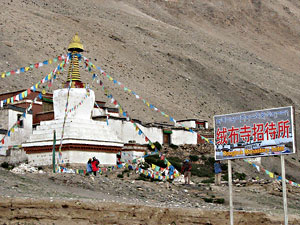|
|
Rongbuk Monastery, Tibet |
|
Rongbuk Monastery |
|
Rongbuk
Monastery is one of the highest monastery in the world.
Located at the elevation 4800 meters it is the last
inhabited spot before Everest Base Camp. Rongbuk
monastery is situated in Basum Township, in Shigaste
Prefecture of the Tibetan Autonomous Region, China. When
seen from this monastery Mt. Everest appears like a
lofty pyramid surrounded by mountains that touch the
sky. When a pile of the thick clouds float above the
peak on sunny days, it creates the magical site of 'The
Highest Flag Cloud in the World'. The monastery is
accessible today via vehicle by means of an undeveloped
road. |
 |
|
Rongbuk Monastery was built by a local lama
in about 1899. It was built in an area of meditation huts that
had been in use by monks and hermits for over 400 years.
Hermitage meditation caves dot the cliff walls all around the
monastery complex and up and down the valley. Many walls and
stones, carved with sacred syllables and prayers, line the
paths. Zatul Rinpoche, the lama who founded this monastery was
much respected by the Tibetans. In olden times, the Monastery
was a active centre of the teachings. It was a site of special
pilgrimage during the annual ceremonies with masked dancers.
Throngs of the faithful would come from far and wide—some from
Nepal and Mongolia—and sit on every level of all the
many-tiered flat roofs of the monastery to watch the masked
dancers in the great open courtyard. Cymbals clanged amid the
ceaselessly overlapping thunder of the long Tibetan trumpets
played in relay to accompany the monk dancers in their ritual.
These ceremonies were shared with the satellite monasteries
across the Himalaya also founded by the Rongbuk Lama. The
ceremonies survive to this day, notably at the Sherpa
monastery at Tengboche. The monastery houses a vast collection
of books and costumes, which had been taken for safekeeping to
Tengboche, were lost in a 1989 fire.
The monastery has five-tier building, but only two floors are
in use now. In the front is the main hall, where there are the
statues of Sakyamuni and Guru Rinpoche. There is a beautiful,
large, round chorten, a reliquary with religious significance
embedded in its terraced structure and crown of emblems of the
sun and moon, symbolizing the light of Buddha's teaching.
In Rongbuk monastery both the monks and nuns reside and
celebrate the Buddhist festivals together. Monastery hold the
three days Saga Dawa Festival which is held to celebrate the
birth of Sakyamuni. During the play, many monks disguise
themselves as Rabbis and dance many scenes one after another,
and most scenes portray different characters and clothing.
Another Tibetan festival is held in the month of December of
Tibetan Calendar to placate wandering ghosts, and monks
The chorten dramatically marks this last human dwelling place
before one heads up to the stark valley to Base Camp. Walking
forward from Rongbuk Monastery, you can see the famous Rongbuk
Glacier Zone, which is the largest among all the hundreds of
glaciers formed around the Mt. Everest. The three glaciers
north of the Mt. Everest flow south and assemble at a river
traversing the foot of the monastery. This is called 'Rongbuk
River', and the water here is extremely cold. |
|